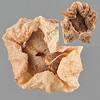Non-Grass Disseminules Explained
Fruit and seed dispersal
For angiosperms, the primary reproductive structure is the seed, which is encased in and protected by its outer coat (testa) and to varying extents by fruit tissues (pericarp). Seed and pericarp modifications primarily function to aid in dispersal of the disseminule—by providing wings or tufts of hair for sailing through the air, burs and barbed awns for attachment to animal fur, bladders for water dispersal, color and sugars for the attraction of herbivores who deposit the undigested seeds with their excrement, or explosive capsules which send seeds flying. For this tool, we are most interested in fruits, fruit fragments or seeds, that, by virtue of their small size and/or attached structures, are capable of being windblown from the parent plant or from the top layers of the soil bank into a table grape bunch while it is on the vine or during the harvest process.
Recognizing fruit disseminules in this tool
Sometimes it is difficult to distinguish a fruit from a seed. This is particularly the case for single-seeded, dry, indehiscent (i.e., non-opening) fruits such as the grass caryopsis (discussed under Grass disseminules explained), the cypsela of the Asteraceae, or the achene, which is found in various plant families. These fruits are often casually referred to as “seeds” or “seed units” because of the overall resemblance of the unit to a true seed and because of the difficulty involved in trying to separate the seed from the typically adherant tissues of the fruit. The true nature of these fruits is often given away by the presence of accessory structures designed to facilitate dispersal (e.g., the tuft of hair or pappus attached to the floral end of some cypselae of the Asteraceae, the winged perianth of various members of the Chenopodiaceae and Polygonaceae). Even though some of these structures, e.g., wings, can occur on seeds, they are more frequently found on fruits that function as disseminules (Figure 1).
Figure 1. Fruits that do not release their seed but function as disseminules themselves.
Often, wings are made from modified perianth bracts, which remain on the fruit after maturation to facilitate dispersal. These bracts can be strongly adherant, as in the case of some Polygonaceae where the disseminule is almost always the bracted fruit. In other taxa, the bracts may be somewhat loose and subject to loss or fragile and subject to destruction. In these taxa, the disseminule may be the bracted or the naked fruit and the key is designed with both possibilities in mind.
Indehiscent but fleshy fruits, such as berries or drupes, have evolved to attract herbivores. The seeds are often swallowed whole as part of the ingested fruit and then passed onto the ground, more or less intact, with the animal's excrement. If found before ingestion but after some dessication has occurred, the disseminule may consist of seed(s) firmly encased in their shrivelled fruit coat as seen in some berries of the Solanaceae. While it is doubtful that the heavy fleshy fruits would find their way into grape bunches, strong winds could transfer the tiny seeds or a small number of seeds encased in a dried fruit coat. In both cases, use the General Key by referencing the seed characters only.
Fruit fragments as disseminules
A few dehiscent (i.e., opening upon maturity) fruit types (e.g., schizocarps and nutlets) split into segments (e.g., mericarps or single nutlets) in which some fruit tissue remains firmly attached to each seed. This fruit segment constitutes the disseminule for species with these fruit types and examples are found in the Apiaceae, Boraginaceae (Figure 2), Lamiaceae, and Malvaceae (Figure 3). These fruit segments often have a distinctive appearance, including having recognizable abaxial (i.e., facing outwards or away from the fruit attachment scar) and adaxial (i.e., facing inward) sides. The similar terms dorsal and ventral are used interchangeably.
Recognizing seed disseminules in this tool
The most common dehiscent fruit type found among the taxa of this tool is the capsule, which is typically dry and multi-seeded. For species with capsules, the disseminule is typically the seed alone. Seeds of different taxa are differentiated by several characters—including size and shape (often variable within a species), color (not always reliable), location and nature of the hilum (i.e., the scar remaining where the seed had been joined to pericarp tissues via the funiculus), shape of the embryo within the testa (not always easy to tell), surface texture, and the occurrence of appendages, among others. Seeds are generally described with the hilum being in a basal or peripheral position. Rarely, abaxial and adaxial faces of a seed are distinguishable (Figure 4).
Multiple disseminule types
In some taxa, the disseminule may come in multiple forms—as the entire fruit, a fruit fragment or a seed. This is seen when dehiscence is variable or incomplete as in the pods of some species of the Fabaceae and in the two-chambered silicles of some species in the Brassicaceae (Figure 5). In these cases, the key takes into account all probable disseminule types.
A few single-seeded, dry, indehiscent fruit types have fruit tissues that are easily scraped off of the surface of the seed (e.g., the thin pericarps of utricle; also, some utricles are dehiscent). In these cases, the disseminule may appear with an intact pericarp or as a naked seed. Again, the key considers both possibilites.



